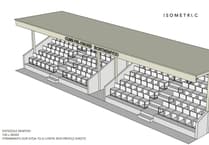Fears over declining red squirrel populations in mid-Wales have prompted an expansion of a conservation area to cover Lampeter, Tregaron and Pontrhydfendigaid.
The Mid Wales Red Squirrel Partnership (MWRSP) has announced that it is increasing the size of its focal site to also include Cwm Rhaeadr and Upper Tywi.
The partnership says the larger area represents an important step in conserving the ‘last remaining genetically unique population of red squirrels in Wales’.
The expansion aims to reflect the increased range of red squirrels, and control grey squirrels in more urban areas around the Cambrian Mountains.
Populations of the threatened species are at risk from larger and more aggressive greys, an invasive species in the UK, which compete with reds for food and habitat.
They also carry the squirrel pox virus, which is deadly to their smaller relations.
The buffer zone, which formerly followed the Teifi River, now encompasses more urban areas like Lampeter where grey squirrel control may now be undertaken.
The Wildlife Trust of South and West Wales, which is aiming to reduce grey squirrel populations to allow their red counterparts to prosper, strongly encourages people to use squirrel-proof bird feeders to achieve this.
Red Squirrel Species Champion in the Senedd, Darren Millar, said: “This expansion represents a huge step forward for the Mid-Wales Red Squirrel Partnership, but the fight to save this quintessential species is far from over.
“We cannot save red squirrels without action, so if you do one thing, consider squirrel-proofing your bird feeders.
“Every free meal the grey squirrels raid from your garden increases their population and is another nail in the coffin for the reds.”
The red squirrel population in mid-Wales has experienced a crash in the last year.
Conservationists estimate only 50-150 individuals remain, which is commonly cited as the tipping point for the survival of the species.
The Mid Wales Red Squirrel Partnership is seeking long-term funding to continue its work to save this ‘ecologically and culturally important species’.




